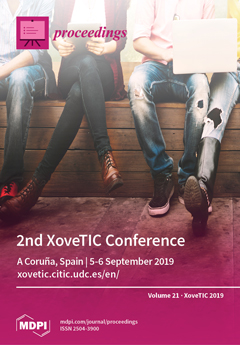Proceedings, 2019, XoveTIC 2019
The 2nd XoveTIC Conference (XoveTIC 2019)
A Coruña, Spain | 5-6 September 2019
Volume Editor:
Alberto Alvarellos González, University of A Coruña, Spain
José Joaquim de Moura Ramos, University of A Coruña, Spain
Beatriz Botana Barreiro, University of A Coruña, Spain
Javier Pereira Loureiro, University of A Coruña, Spain
Manuel F. González Penedo, University of A Coruña, Spain
Printed Edition Available!
- Issues are regarded as officially published after their release is announced to the table of contents alert mailing list.
- You may sign up for e-mail alerts to receive table of contents of newly released issues.
- PDF is the official format for papers published in both, html and pdf forms. To view the papers in pdf format, click on the "PDF Full-text" link, and use the free Adobe Reader to open them.



